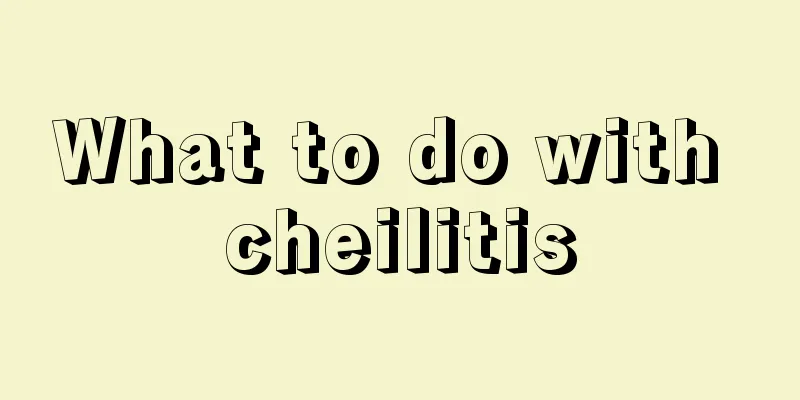What to do with cheilitis

|
Do you know what cheilitis is? The most obvious symptom of this disease is lip peeling and cracking. This is a mucosal disease. There are many types of cheilitis, including allergic cheilitis, dry and scaly cheilitis, glandular cheilitis, benign lymphoproliferative cheilitis, and cheilitis can also be divided into acute and chronic. If you suffer from cheilitis, you must seek timely treatment. So what should you do with cheilitis? Cheilitis is a very common oral disease. After suffering from this disease, the lips will become dry and peeling, and there will also be symptoms of chapped lips. Sometimes there will also be symptoms of burning or itching and pain. This has a great impact on patients. It must be treated when it is discovered. But what should be done about cheilitis? It can occur on both the upper and lower lips, but is more common on the upper lip. There are two manifestations: 1 Dryness and desquamation: The red part of the lips is dry, desquamated and cracked. There is oozing or bleeding from the tear. Some patients may be asymptomatic, while others may feel dry, burning, itchy or painful lips. Some bite their lips to relieve the itching or tear off scales, which worsens the condition. 2 Exudative scab: The lips are swollen, eroded, with inflammatory exudate and bleeding, forming pus or blood scabs. When the scabs are torn off, the eroded surface will remain. The pain and scabs make it difficult to move the lips. The disease may be mild or severe at times, recur repeatedly, and persist without recovery. 3. Symptoms include dryness of the red part of the lips: desquamation and cracking. Severe symptoms include lip swelling and erosion, inflammatory exudate, formation of blood or pus scabs, obvious pain, and a burning sensation. Severe patients will experience symptoms such as high fever, muscle and joint pain, headache, cough, and erythematous blisters all over the body. After the blisters rupture, large areas of skin will fall off, which is called "toxic epidermal necrolysis." 4 Allergic cheilitis: more common on the lower lip, with erosion of the lip vermilion, light yellow exudate not exceeding the edge of the lip vermilion, mild swelling of the lips, lip eversion, and severe swelling with bleeding or ulceration, and blood scab. After the scab is removed, a bleeding wound is exposed, or there is pus and blood. Local burning, pain, dryness, and itching. The pain is aggravated by friction, and lip movement is restricted. The disease is difficult to cure and can last for several months or longer. The submandibular lymph nodes are swollen and there is local pigmentation. The symptoms of benign lymphoproliferative cheilitis are similar to those of photosensitive cheilitis, with erosion, ulcers, pus and blood crusts, desquamation, chapped skin, pain, swelling, etc. In addition, short white stripes may appear on the red edge of the lips and near the mucous membrane, which is similar to discoid lupus erythematosus, but the lesions do not exceed the red edge of the lips, and there is no rash. The erosive type of lichen planus has a smaller range of lip erosions, and there must be white patterns around it. Erythema multiforme exudative has an acute onset and is more common in young people. It is characterized by erosion, bleeding, and blood crusts. In addition, for lip ulcers that do not heal for a long time, whose area suddenly increases in a short period of time, and whose pain is not severe, the possibility of lip cancer should be ruled out. 5 This disease is equivalent to the category of "lip wind" in traditional Chinese medicine: the disease is mostly caused by Yangming stomach heat, spleen meridian blood dryness, or repeated infection with wind evil, and the combination of wind and heat. Common clinical syndromes include: 6. Stomach fire steaming type: Symptoms include redness, swelling, pain, itching, thirst, bad breath, red urine and constipation, red tongue, thick yellow tongue coating, and rapid pulse. 7 Yin deficiency and internal heat type: symptoms include prolonged lesions, swollen and cracked lips, crusting, desquamation, red and astringent urine, dry stool, dry tongue with little fluid, and a rapid and strong pulse. Western medicine 1 The first step in treatment is to avoid excessive exposure to sunlight, stop using or eating suspicious drugs or foods, avoid dry, hot and windy environments, and change bad habits such as licking lips, which can also prevent recurrence. You can use 0.1% linolenic acid solution or 1/5000 furazolidone solution to moisten the gauze and apply it locally. Apply 3 times a day, each time for 20 to 30 minutes. You can also apply wet compress with 3% saline or 3% boric acid water, and keep the sore surface clean. For small-scale erosion, prednisolone suspension can be injected into the base. For large-scale erosion, prednisone can be taken orally in a short period of time. Antibiotics can be taken if necessary, and chloroquine can be taken orally, 0.25 g per day. The dosage can be reduced after 1 week, and the toxic side effects should be observed. Local irradiation with helium-neon laser can also be used to treat cheilitis. 2 You can use drug ion introduction method to introduce 5% to 10% potassium iodide or 5% procaine into the lips, or apply corticosteroid ointment, such as Fuqing Ointment. For fungal cheilitis, apply Mi cream topically. 3. Avoid all external stimulation and correct bad habits. 4 When scab forms, apply 0.1% Rafenur wet compress and ulcer ointment. 5 For those with very mild desquamation and no subjective symptoms, you can apply a small amount of lip balm. Folk remedies 1 Wash two fresh tomatoes that are not too raw, squeeze out the juice, hold it in your mouth for two minutes and spit it out. Repeat three times and then rinse your mouth with clean water. Do this once in the morning and once in the evening every day. After about three days, the cheilitis will disappear. 2 Boil half a dozen eggs in boiling water, remove the shells and egg whites, and put 6 egg yolks in a dry pan. Fry them over low heat to remove moisture, then fry the egg yolks over high heat until they are burnt black and oil comes out. Store the oil in a small bottle and apply it to the affected area after it cools down. Apply three times a day. Everyone should know what to do about cheilitis. This disease has a great impact on us. We must choose the treatment method that suits us in time. The effect of general Western medicine treatment will be very good. Patients with cheilitis should also do a good job of care in daily life. Do not lick your lips. This bad habit must be changed. You should also apply anti-cracking lip balm frequently. |
<<: Alanine aminotransferase is high
Recommend
How to quickly treat thyroid cancer
How to quickly treat thyroid cancer? The thyroid ...
What are the acupoints for clearing the lungs?
For various reasons, people often have coughing s...
Complete list of methods to remove formaldehyde
We all know that when moving into a new house, di...
Do rectal polyps require surgery?
Rectal polyps are common diseases in anorectal me...
What is the difference between sanitary napkins
Everyone should know about sanitary napkins. They...
How to prevent gray hair
In this amazing world, anything can happen. White...
Lung cancer patients experience hip pain and leg pain
Hip bone generally refers to the hip bone. Lung c...
How to treat stomach cold symptoms
The most common symptoms of stomach cold are stom...
Homemade Rose Hydrosol
Rose hydrosol, also known as rose water essential...
What to eat for dry mouth
Some people don’t like to drink water, but if the...
Can aging eyes be restored?
As people age, their eyesight will gradually weak...
If you have lymphoma, you may find swollen lymph nodes
If you have lymphoma, you may find that your lymp...
What are the symptoms of melanoma? How is melanoma diagnosed?
The main clinical symptoms are dysphagia and dysp...
How does tracheitis develop?
Tracheitis is a chronic disease. People suffering...
How to soak olives in wine
Olives are a familiar food to many people. Olives...









